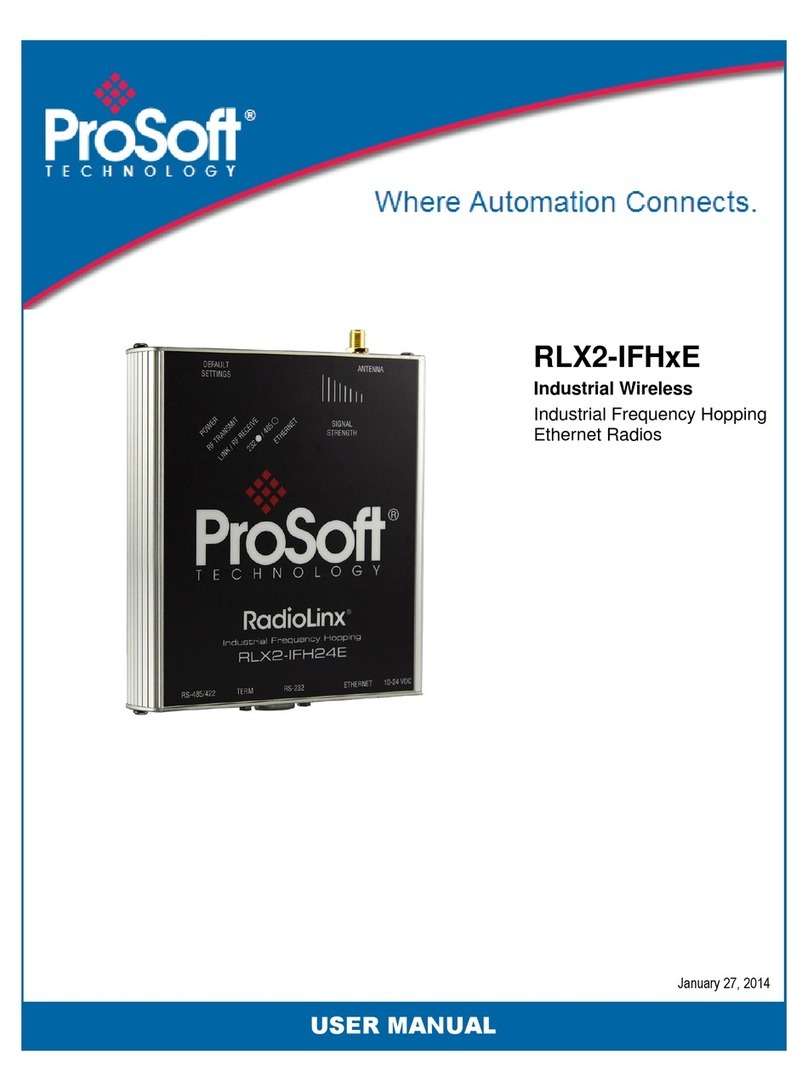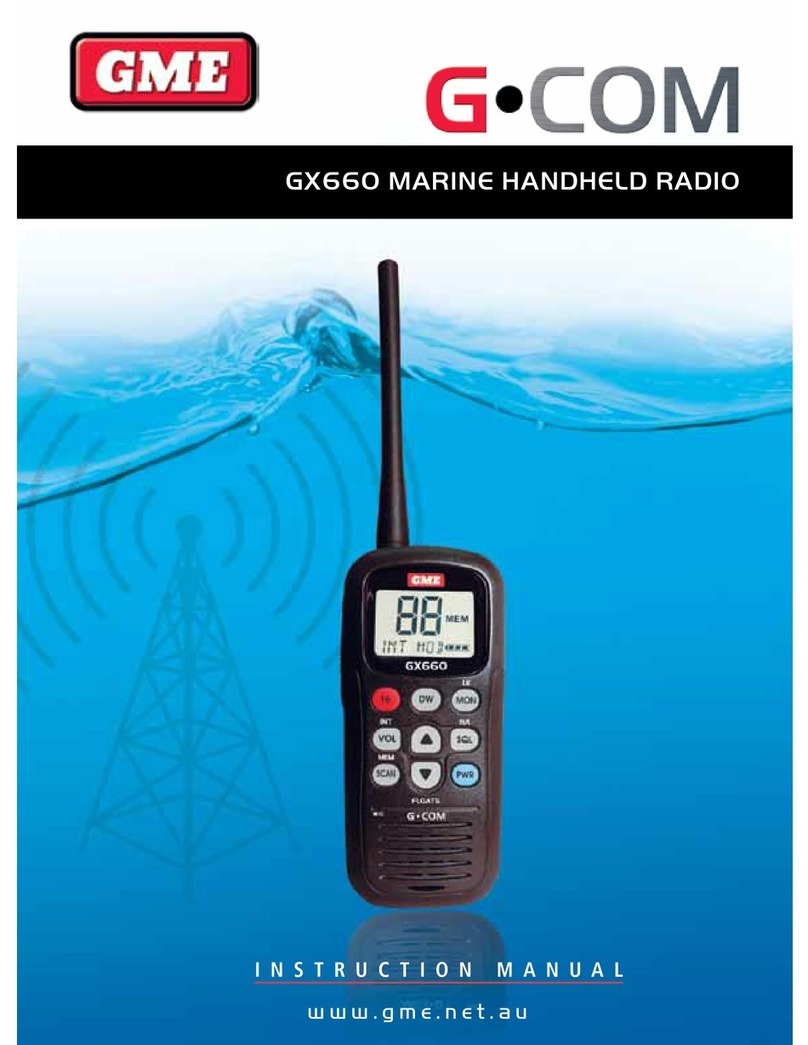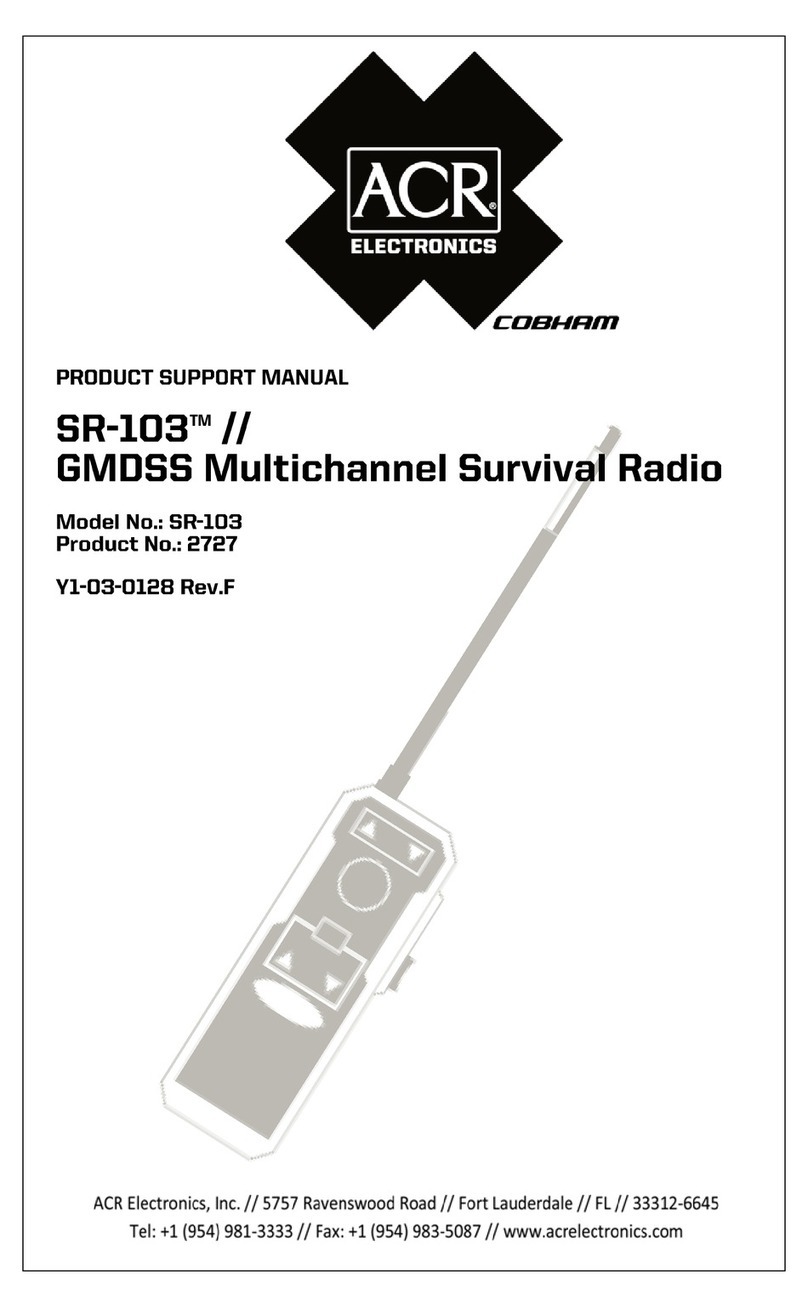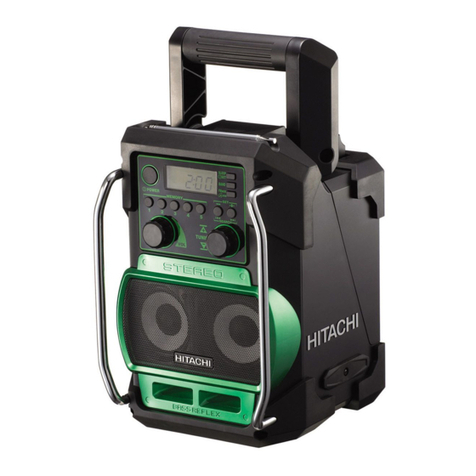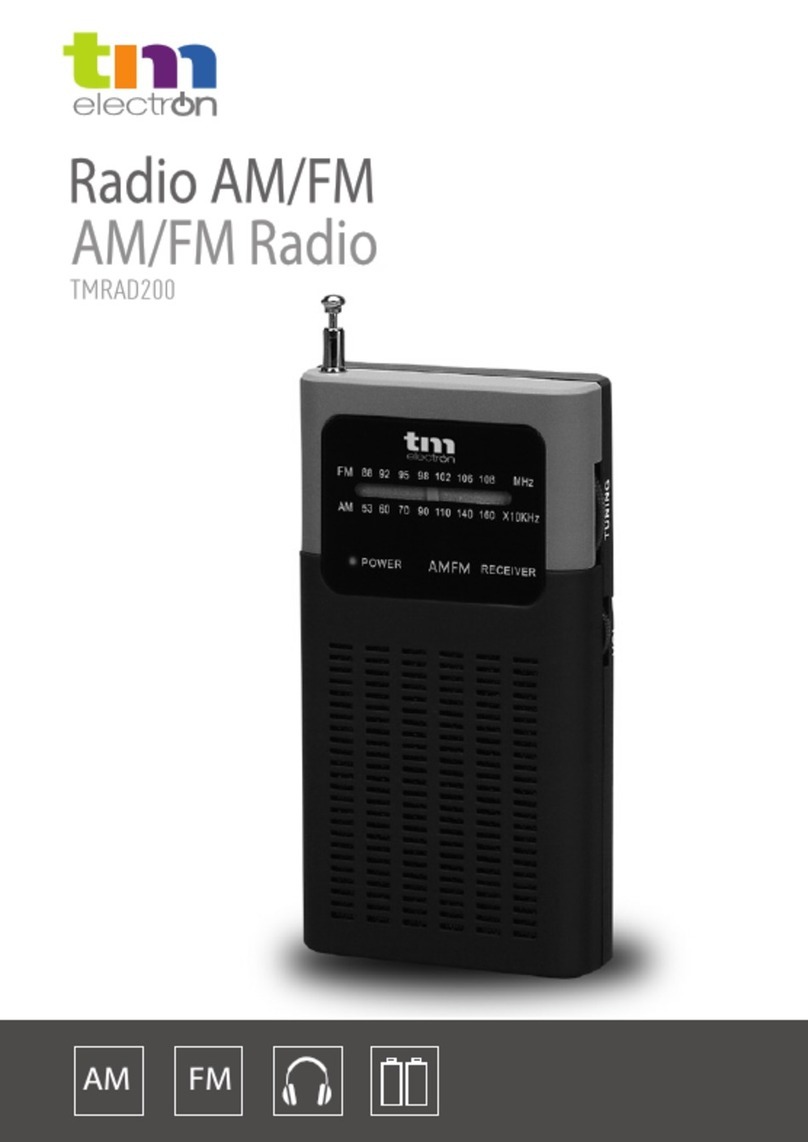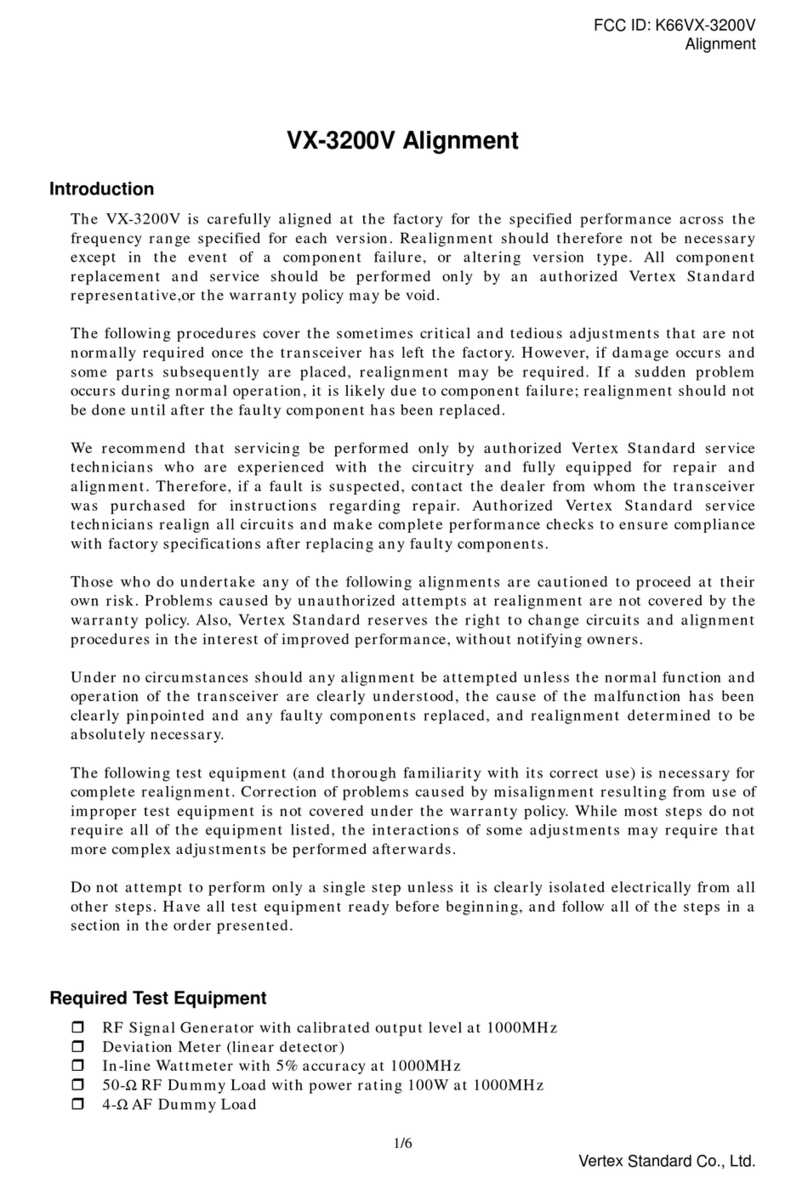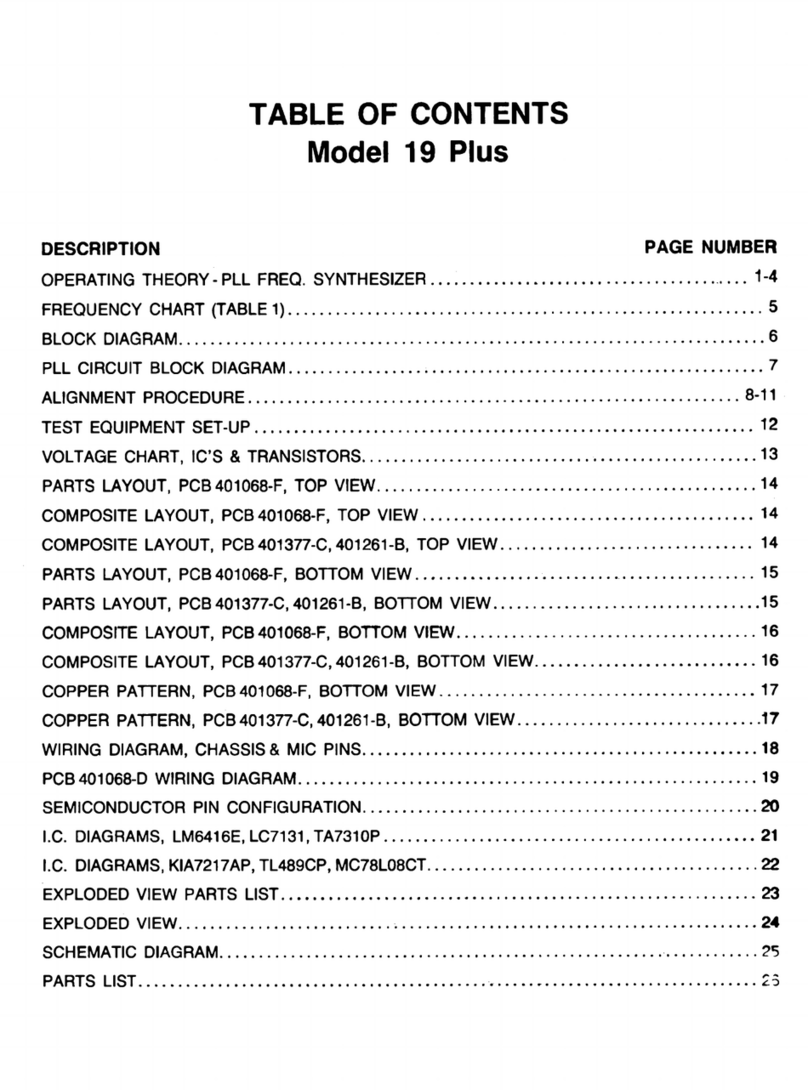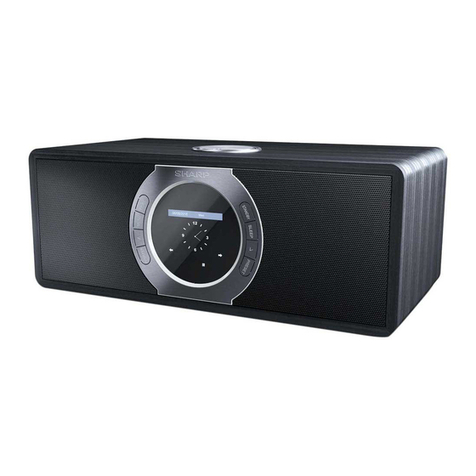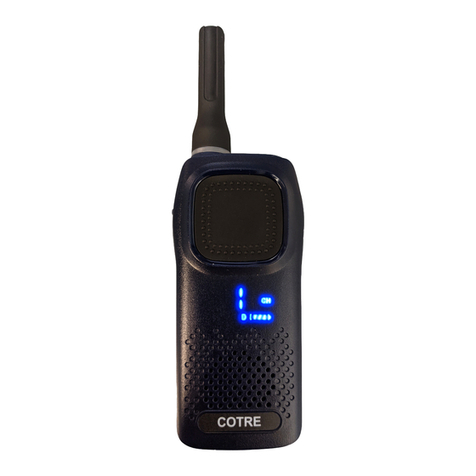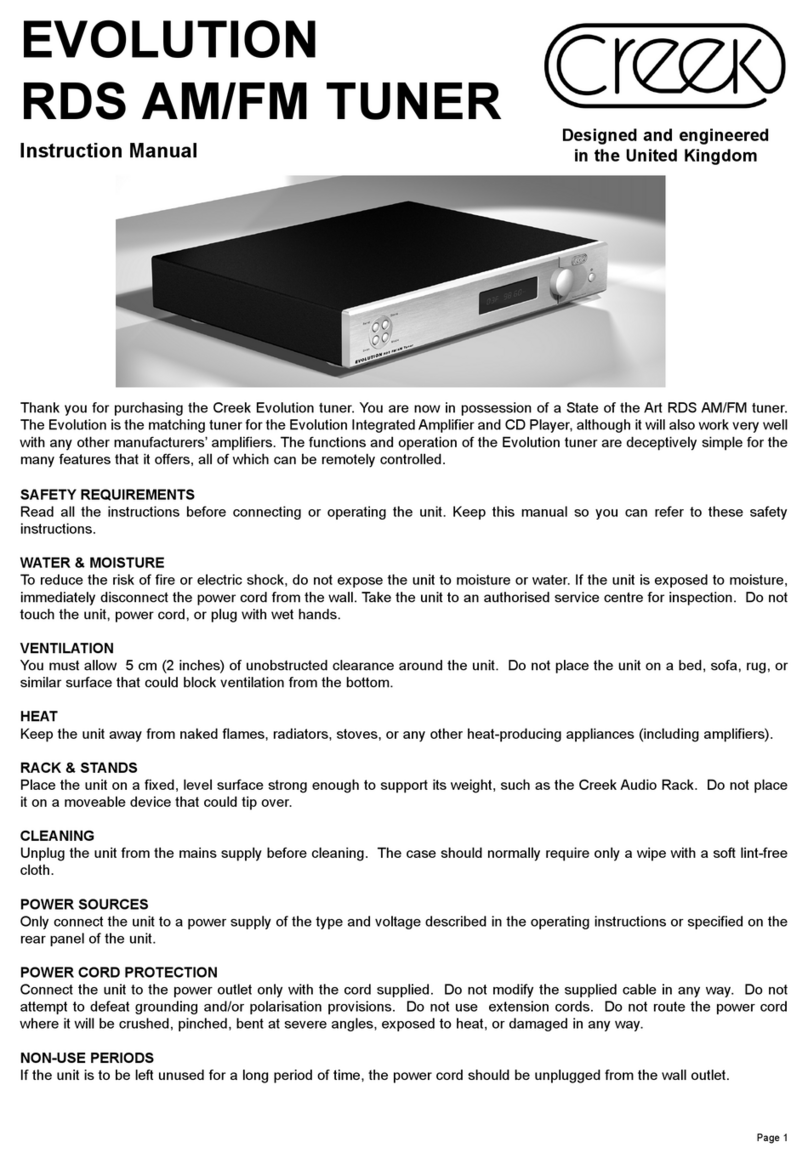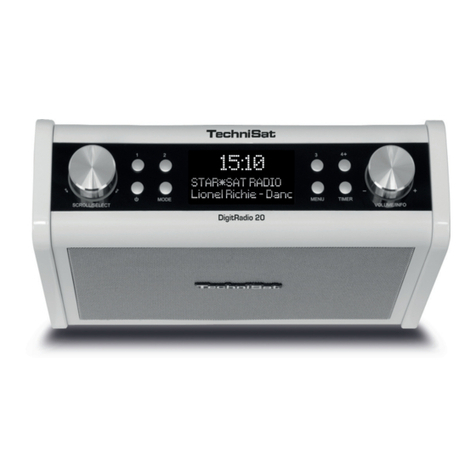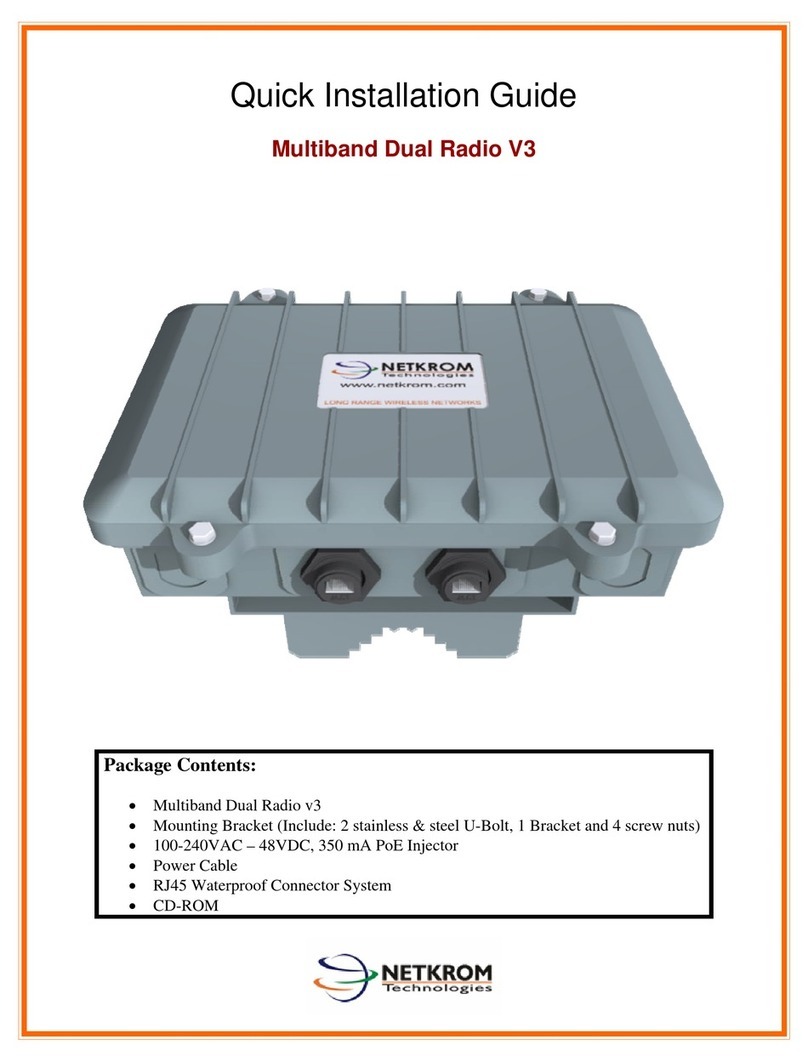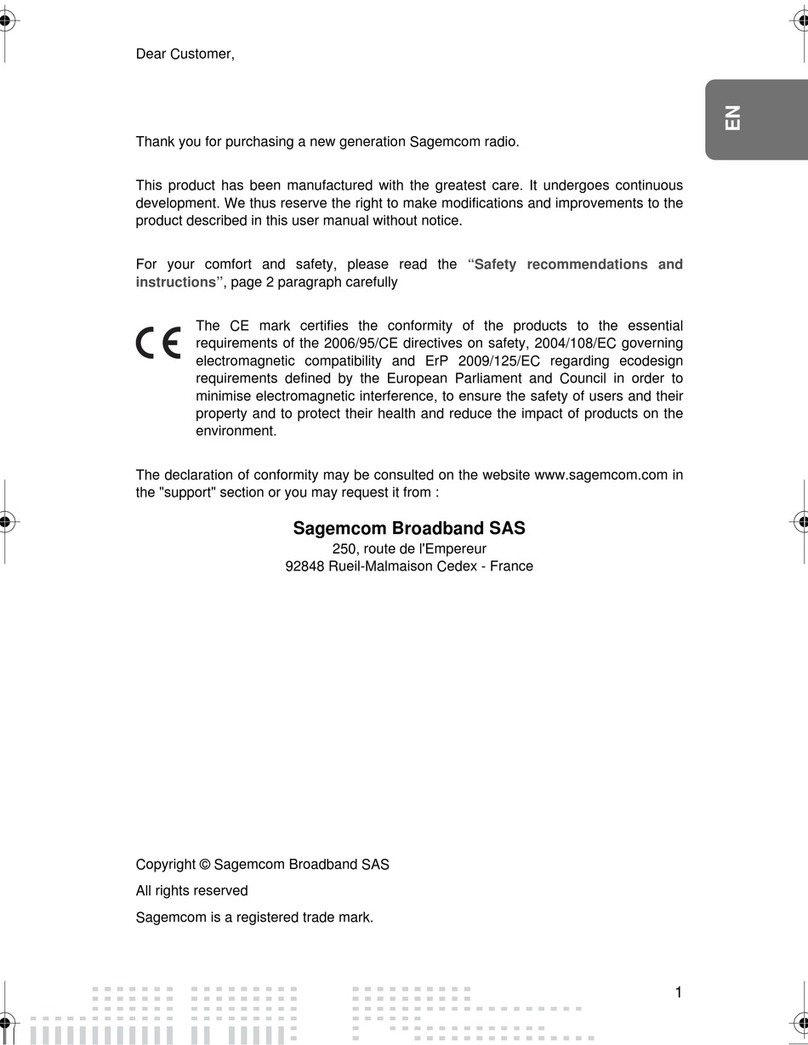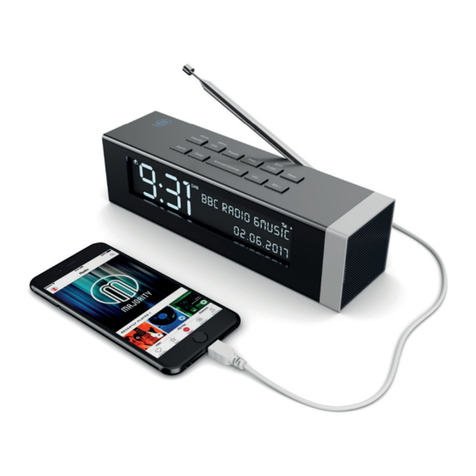ProSoft RadioLinx RLX-IFHS User manual

RLX-IFHS
RadioLinx Industrial Wireless
RadioLinx®Industrial Frequency
Hopping Serial Radios
November 19, 2013
USER MANUAL

Your Feedback Please
We always want you to feel that you made the right decision to use our products. If you have suggestions, comments,
compliments or complaints about our products, documentation, or support, please write or call us.
How to Contact Us
ProSoft Technology
5201 Truxtun Ave., 3rd Floor
Bakersfield, CA 93309
+1 (661) 716-5100
+1 (661) 716-5101 (Fax)
www.prosoft-technology.com
Copyright © 2013 ProSoft Technology, Inc., all rights reserved.
RLX-IFHS User Manual
November 19, 2013
ProSoft Technology ®, ProLinx ®, inRAx ®, ProTalk ®, and RadioLinx ®are Registered Trademarks of ProSoft
Technology, Inc. All other brand or product names are or may be trademarks of, and are used to identify products
and services of, their respective owners.
ProSoft Technology®Product Documentation
In an effort to conserve paper, ProSoft Technology no longer includes printed manuals with our product shipments.
User Manuals, Datasheets, Sample Ladder Files, and Configuration Files are provided on the enclosed CD-ROM,
and are available at no charge from our web site: www.prosoft-technology.com

Important Safety Information
The following Information and warnings pertaining to the radio module must be heeded:
WARNING –EXPLOSION HAZARD –DO NOT REPLACE ANTENNAS UNLESS POWER HAS BEEN SWITCHED
OFF OR THE AREA IS KNOWN TO BE NON-HAZARDOUS.
"THIS DEVICE CONTAINS A TRANSMITTER MODULE, FCC ID: . PLEASE SEE FCC ID LABEL ON BACK OF
DEVICE."
"THIS DEVICE USES AN INTERNAL COMPACT FLASH RADIO MODULE AS THE PRIMARY RADIO
COMPONENT. THE COMPACT FLASH RADIO MODULE DOES NOT HAVE AN FCC ID LABEL. THE COMPACT
FLASH RADIO MODULE HAS NO USER SERVICEABLE PARTS."
"THIS DEVICE COMPLIES WITH PART 15 OF THE FCC RULES. OPERATION IS SUBJECT TO THE FOLLOWING
TWO CONDITIONS: (1) THIS DEVICE MAY NOT CAUSE HARMFUL INTERFERENCE, AND (2) THIS DEVICE
MUST ACCEPT ANY INTERFERENCE RECEIVED, INCLUDING INTERFERENCE THAT MAY CAUSE
UNDESIRED OPERATION."
"CHANGES OR MODIFICATIONS NOT EXPRESSLY APPROVED BY THE PARTY RESPONSIBLE FOR
COMPLIANCE COULD VOID THE USER’s AUTHORITY TO OPERATE THE EQUIPMENT."
Industry Canada Requirements:
"THIS DEVICE HAS BEEN DESIGNED TO OPERATE WITH AN ANTENNA HAVING A MAXIMUM GAIN OF 24 dB.
AN ANTENNA HAVING A HIGHER GAIN IS STRICTLY PROHIBITED PER REGULATIONS OF INDUSTRY
CANADA. THE REQUIRED ANTENNA IMPEDANCE IS 50 OHMS."
"TO REDUCE POTENTIAL RADIO INTERFERENCE TO OTHER USERS, THE ANTENNA TYPE AND ITS GAIN
SHOULD BE CHOSEN SUCH THAT THE EQUIVALENT ISOTROPICALLY RADIATED POWER (EIRP) IS NOT
MORE THAN THAT REQUIRED FOR SUCCESSFUL COMMUNICATION."
"THE INSTALLER OF THIS RADIO EQUIPMENT MUST INSURE THAT THE ANTENNA IS LOCATED OR
POINTED SUCH THAT IT DOES NOT EMIT RF FIELD IN EXCESS OF HEALTH CANADA LIMITS FOR THE
GENERAL POPULATION; CONSULT SAFETY CODE 6, OBTAINABLE FROM HEALTH CANADA."
Recommended Antennas
Part Number
Max Gain
Part Number
Max Gain
Part Number
Max Gain
A902S-OA
2 dBi
A2424NJ-DB
24 dBi
A2410NJ-DY
10 dBi
A907NJ-OC
7 dBi
A082503-80-OBH
3 dBi
A2415NJ-DY
15 dBi
A908NJ-DY
8 dBi
A911NJ-DY
11 dBi
A2402S-OS
2 dBi
A2402S-OSLP
2 dBi
A2403NBH-OC
3 dBi
A2404NBHW-OC
4 dBi
A2404NJ-OC
4 dBi
A2405S-OA
5 dBi
A2405S-OM
5 dBi
A2505S-OS
5 dBi
A2406NJ-OC
6 dBi
A2406NJ-OCD
6 dBi
A2408NJ-OC
8 dBi
A2409NJ-OCD
9 dBi
A2415NJ-OC
15 dBi
A902NJ-OC
2 dBi
A902S-OA
2 dBi
A903NBH-OC
3 dBi
A903S-OM
3 dBi
A905NJ-OC
5 dBi
A907NJ-OC
7 dBi
A2408NJ-DP
8 dBi
A2413NJ-DP
13 dBi
A2416NJ-DP
16 dBi
A2419NJ-DP
19 dBi
A912NJ-DP
12 dBi
A2419NJ-DB
19 dBi

An adapter may be needed for some of the listed antennas to operate with the specified radio.
Antenna spacing requirements for user safety
It is important to keep the radio's antenna a safe distance from the user. To meet the requirements of FCC part
2.1091 for radio frequency radiation exposure, this radio must be used in such a way as to guarantee at least 20 cm
between the antenna and users. Greater distances are required for high-gain antennas. The FCC requires a
minimum distance of 1 mW *cm2 power density from the user (or 20 cm, whichever is greater).
If a specific application requires proximity of less than 20 cm, the application must be approved through the FCC for
compliance to part 2.1093.
Important Installation Instructions
This equipment is suitable for use in Class I, Division 2, Groups A, B, C and D OR non-hazardous locations only.
WARNING –EXPLOSION HAZARD –DO NOT DISCONNECT EQUIPMENT UNLESS POWER HAS BEEN
REMOVED OR THE AREA IS KNOWN TO BE NON-HAZARDOUS.
WARNING –EXPLOSION HAZARD - SUBSTITUTION OF ANY COMPONENTS MAY IMPAIR SUITABILITY FOR
CLASS I, DIVISION 2.
Power must be provided from NEC Class 2 Circuit or a Limited Power Source.
EU Requirements
1. For outdoor use, France has a frequency restriction of 2.4 GHz to 2.454 GHz for an output power greater than 10
mW and below 100 mW.
2. For outdoor use in France, the output power is restricted to 10 mW in the frequency range of 2.454 GHz to 2.4835
GHz.
3. 5.15 GHz to 5.35 GHz is restricted to 200 mW EIRP throughout the European Union.
RadioLinx IFH: FCC Part 15 & Industry Canada Rules
The statements contained in this "Regulatory Approvals" section are required. If the ProSoft Technology, RadioLinx
wireless modem and switches are used as a component of any device, these statements must be a component of
that device’s product documentation.
RadioLinx IFHS: COMPLIANCE STATEMENT
The ProSoft Technology, RadioLinx devices comply with Part 15 of the FCC Rules as well as Industry Canada Rules.
Operation is subject to the following two conditions:
This device may not cause harmful interference, and,
This device must accept any interference received, including interference that may cause undesired operation.
In Canada, this device is to be operated indoors only and away from windows to provide maximum shielding and to
prevent radio interference to the Canadian licensed service. Equipment (or its transmit antenna) that is installed
outdoors in Canada is subject to licensing.
Note: The ProSoft Technology, RadioLinx module is labeled with an FCC ID number and a Canadian Certification
Number. If this label is not visible when installed in an end-device, the outside of the device MUST also display a
label referring to the enclosed RadioLinx. Use wording on the label similar to the following:
RLX-IFH9S: "Transmitter Module FCC ID: OQ7OS2400, Canada 36561031989A"
RLX-IFH24S: "Transmitter Module FCC ID: NS907P22, Canada 3143A07P22"
OR
RLX-IFH9S: "This device contains Transmitter Module FCC ID: OQ7OS2400, Canada 36561031989A"

RLX-IFH24S: "This device contains Transmitter Module FCC ID: NS907P22, Canada 3143A07P22"
WARNING: Changes or modifications to this radio module not expressly approved by its manufacturer, ProSoft
Technology, may void the user’s authority to operate the equipment.
Agency Approvals & Certifications
Wireless Approvals
Visit our web site at www.prosoft-technology.com for current wireless approval information.
Hazardous Locations
ANSI/ISA
CSA
ATEX
Ordinary Locations
CSA/CB
FCC/IC
ETSI
Agency Approvals & Certifications
Wireless Approvals
Visit our website at www.prosoft-technology.com for current wireless approval information.


RLX-IFHS ♦ RadioLinx Industrial Wireless Contents
RadioLinx® Industrial Frequency Hopping Serial Radios User Manual
ProSoft Technology, Inc. Page 7 of 107
November 19, 2013
Contents
Your Feedback Please........................................................................................................................2
How to Contact Us..............................................................................................................................2
ProSoft Technology®Product Documentation....................................................................................2
Important Safety Information...............................................................................................................3
Recommended Antennas ...................................................................................................................3
Antenna spacing requirements for user safety ...................................................................................4
Please Read This Notice ....................................................................Error! Bookmark not defined.
EU Requirements................................................................................................................................4
RadioLinx IFH: FCC Part 15 & Industry Canada Rules......................................................................4
RadioLinx IFHS: COMPLIANCE STATEMENT..................................................................................4
Agency Approvals & Certifications......................................................................................................5
Agency Approvals & Certifications......................................................................................................5
Guide to the RLX-IFHS User Manual 11
1Start Here 13
1.1 About the RadioLinx Industrial Frequency Hopping Radios ...................................14
1.1.1 Product Specifications - RLX-IFH9S.......................................................................14
1.1.2 Product Specifications - RLX-IFH24S.....................................................................16
1.2 Package Contents...................................................................................................18
1.3 System Requirements.............................................................................................19
1.4 Install ControlScape FH Configuration Software ....................................................20
1.5 Planning the Network..............................................................................................21
1.5.1 Installation Questions..............................................................................................22
1.5.2 ProSoft Wireless Designer......................................................................................23
1.6 Configuring the Radios............................................................................................25
1.6.1 Start ControlScape FH ............................................................................................25
1.6.2 Set Up the Network.................................................................................................26
1.6.3 General Radio Configuration...................................................................................31
1.6.4 Set Up the Master Radio.........................................................................................32
1.6.5 Add Remote Radios................................................................................................36
1.6.6 Add Repeaters ........................................................................................................37
1.6.7 Graphically Define the RF Link ...............................................................................38
1.6.8 Save the Network Configuration .............................................................................40
1.6.9 Transfer the Configuration to the Remote Radios ..................................................41
1.7 Planning the Physical Installation............................................................................44
1.8 Test the Network Installation Plan...........................................................................45
1.9 Verify Communication.............................................................................................46
1.9.1 View Operating Network..........................................................................................46
1.9.2 Viewing Signal Strength..........................................................................................47
1.9.3 Query a Radio Directly ............................................................................................48
1.9.4 Query a Radio Remotely.........................................................................................49
2Installing the Radios 51
2.1 Radio Hardware ......................................................................................................52
2.1.1 Radio power requirements......................................................................................52
2.1.2 Connecting antennas ..............................................................................................53

Contents RLX-IFHS ♦ RadioLinx Industrial Wireless
User Manual RadioLinx® Industrial Frequency Hopping Serial Radios
Page 8 of 107 ProSoft Technology, Inc.
November 19, 2013
2.2 Connecting the Radio to a Network Device............................................................ 54
2.2.1 Cable Connections ................................................................................................. 54
3Diagnostics and Troubleshooting 59
3.1 Diagnostics Overview ............................................................................................. 60
3.2 LED Indicators ........................................................................................................ 61
3.3 Sources of Interference .......................................................................................... 62
3.3.1 Change a Network's Channel................................................................................. 63
3.3.2 Viewing Radio Channel Noise Level ...................................................................... 64
3.3.3 IFHE Spectrum Analyzer Dialog Box...................................................................... 65
3.4 Troubleshoot ControlScape FH Error Messages.................................................... 66
3.4.1 Radio Configuration Status Dialog Box .................................................................. 66
3.4.2 Automatic Baud Detection Dialog Box.................................................................... 66
3.4.3 Invalid Password Dialog Box.................................................................................. 66
3.4.4 Connection Errors................................................................................................... 67
3.5 Troubleshoot Missing Radios ................................................................................. 68
3.6 RadioLinx OPC Server ........................................................................................... 69
3.6.1 System Requirements ............................................................................................ 69
4Reference 71
4.1 Antennas................................................................................................................. 72
4.1.1 Antenna location, spacing, and mounting............................................................... 72
4.1.2 Antenna Pattern...................................................................................................... 73
4.1.3 Antenna Gain.......................................................................................................... 73
4.1.4 Antenna Polarity ..................................................................................................... 74
4.1.5 Whip antennas........................................................................................................ 74
4.1.6 Collinear array antennas......................................................................................... 75
4.1.7 Yagi Array Antenna................................................................................................. 76
4.1.8 Parabolic reflector antennas................................................................................... 77
4.1.9 Adding bi-directional amplifiers............................................................................... 77
4.2 Cable Connections ................................................................................................. 79
4.2.1 Radio RS-485 Cable Specification ......................................................................... 79
4.2.2 Radio RS-232 Cable Specifications ....................................................................... 80
4.3 Serial Port Basics ................................................................................................... 81
5Support, Service & Warranty 83
Contacting Technical Support .......................................................................................................... 83
5.1 Return Material Authorization (RMA) Policies and Conditions............................... 85
5.1.1 Returning Any Product............................................................................................ 85
5.1.2 Returning Units Under Warranty............................................................................. 86
5.1.3 Returning Units Out of Warranty............................................................................. 86
5.2 LIMITED WARRANTY............................................................................................ 87
5.2.1 What Is Covered By This Warranty ........................................................................ 87
5.2.2 What Is Not Covered By This Warranty.................................................................. 88
5.2.3 Disclaimer Regarding High Risk Activities.............................................................. 88
5.2.4 Intellectual Property Indemnity ............................................................................... 89
5.2.5 Disclaimer of all Other Warranties.......................................................................... 89
5.2.6 Limitation of Remedies ** ....................................................................................... 90
5.2.7 Time Limit for Bringing Suit..................................................................................... 90
5.2.8 No Other Warranties............................................................................................... 90

RLX-IFHS ♦ RadioLinx Industrial Wireless Contents
RadioLinx® Industrial Frequency Hopping Serial Radios User Manual
ProSoft Technology, Inc. Page 9 of 107
November 19, 2013
5.2.9 Allocation of Risks...................................................................................................90
5.2.10 Controlling Law and Severability.............................................................................91
Glossary of Terms 92
Index 105

Contents RLX-IFHS ♦ RadioLinx Industrial Wireless
User Manual RadioLinx® Industrial Frequency Hopping Serial Radios
Page 10 of 107 ProSoft Technology, Inc.
November 19, 2013

RLX-IFHS ♦ RadioLinx Industrial Wireless Guide to the RLX-IFHS User Manual
RadioLinx® Industrial Frequency Hopping Serial Radios User Manual
ProSoft Technology, Inc. Page 11 of 107
November 19, 2013
Guide to the RLX-IFHS User Manual
Function
Section to Read
Details
Introduction
(Must Do)
Start Here (page 12)
This section introduces the customer to the
module. Included are: package contents,
system requirements, hardware installation, and
basic configuration.
Configuring the Radios
Set Up the Network
(page 26)
Set Up the Master
Radio (page 32)
Add Remote Radios
and Repeaters
(page 36)
Save the Radio
Configuration (page
35)
This section describes the procedure for
designing and configuring a network of RLX-
IFHS radios.
Installing the Radios
Radio Hardware
(page 52)
Connecting
antennas (page 53)
Connecting Radios
to a Device Network
(page 54, page 54)
This section describes how to install the radio
hardware, connect antennas, and connect the
radios to networked devices.
Diagnostic and
Troubleshooting
Verify
Communication
(page 61, page 46)
Diagnostics and
Troubleshooting
(page 59, page 60)
This section describes how to verify
communications with the network. Diagnostic
and Troubleshooting procedures.
Reference
Physical Installation
Antenna Selection
Glossary
Reference (page 71)
Product
Specifications (page
14)
These sections contain general references
associated with this product, Specifications, and
the Functional Overview.
Support, Service, and
Warranty
Index
Support, Service
and Warranty (page
83)
This section contains Support, Service and
Warranty information.
Index of chapters.

Guide to the RLX-IFHS User Manual RLX-IFHS ♦ RadioLinx Industrial Wireless
User Manual RadioLinx® Industrial Frequency Hopping Serial Radios
Page 12 of 107 ProSoft Technology, Inc.
November 19, 2013

RLX-IFHS ♦ RadioLinx Industrial Wireless Guide to the RLX-IFHS User Manual
RadioLinx® Industrial Frequency Hopping Serial Radios User Manual
ProSoft Technology, Inc. Page 13 of 107
November 19, 2013
1 Start Here
In This Chapter
About the RadioLinx Industrial Frequency Hopping Radios ..................14
Package Contents.................................................................................18
System Requirements...........................................................................19
Install ControlScape FH Configuration Software ...................................20
Planning the Network ............................................................................21
Configuring the Radios..........................................................................25
Planning the Physical Installation..........................................................44
Test the Network Installation Plan.........................................................45
Verify Communication ...........................................................................46

Guide to the RLX-IFHS User Manual RLX-IFHS ♦ RadioLinx Industrial Wireless
User Manual RadioLinx® Industrial Frequency Hopping Serial Radios
Page 14 of 107 ProSoft Technology, Inc.
November 19, 2013
1.1 About the RadioLinx Industrial Frequency Hopping Radios
1.1.1 Product Specifications - RLX-IFH9S
The RLX-IFH9S provides powerful and secure wireless serial communications
and is well suited for demanding, long-range (up to 30+ miles) SCADA and other
serial applications in tough environments. Operating in the license-free 900 MHz
band, the RLX-IFH9S penetrates foliage and walls / ceilings better than higher
frequency radios. With both RS-232 and RS-485 serial ports, serial protocols
such as Modbus RTU, DF1, ASCII and DNP3 are supported. The RLX-IFH9S is
user configurable as a master, repeater and remote radio and employs the 128
bit AES encryption algorithm approved by the United States government for top
secret information.
RLX-IFH9S radios are quickly and easily configured using the included, graphical
ControlScape software. An OPC server software is also included and allows
users to monitor radio network health with any OPC client based HMI software.
General Specifications
Radio
Frequency
902MHz to 928MHz
Security
128 bit AES encryption
Network Topology
Point-to-point, point-to-multipoint, store and
forward repeater
Error Detection
32 bit CRC, ARQ (Automatic Resend Query)
Radio Type
Frequency Hopping Spread Spectrum
Transmit Power (Programmable)
100 mW to 1 W
20 dBm to 30 dBm
Channel data rates
(Programmable)
230, 172, 115 or 19.2 kbps
Receiver Sensitivity (Typical)
230 kbps: -106 dBm @ 10-6 BER
172 kbps: -108 dBm @ 10-6 BER
19.2 kbps: -116 dBm @ 10-6 BER
Outdoor Range
30+ miles pt-pt with high gain directional
antennas and RF line-of-sight

RLX-IFHS ♦ RadioLinx Industrial Wireless Guide to the RLX-IFHS User Manual
RadioLinx® Industrial Frequency Hopping Serial Radios User Manual
ProSoft Technology, Inc. Page 15 of 107
November 19, 2013
Hardware Specifications
Enclosure
Extruded aluminum with DIN and panel mount
Size
104 ´ 94 ´ 53 mm (W ´ H ´ D)
4.1 ´ 3.7 ´ 2.1 inches
Vibration
IEC 60068-2-6 (20g, 3-Axis)
Shock
IEC 60068-2-27 (5g, 10Hz to 150Hz)
Serial Data Ports (2)
DB9, RS-232
RS-422 and RS-485
300 bps to 230 kbps
Configuration Port
DB9, RS-232
Antenna Ports
(1) RP-SMA connector
Weight
1.0 lbs (454 g)
Environmental
Operating Temperature
–40° C to +75° C
Humidity
Up to 100% RH, without condensation
External Power
10Vdc to 24Vdc
Power Consumption
12 W peak
Agency Approvals & Certifications
UL
ISA 12.12.01 Class I Div 2 Groups A, B, C & D, T5.
Must be installed inside an IP54 enclosure that requires tool
access.
CSA/cUL
C22.2 No. 213-M1987
ATEX Category 3, Zone 2
II 3 G
Ex nA IIC T5 X
-30 C <= Ta <= +60 C
WARNING –EXPLOSION HAZARD –DO NOT DISCONNECT EQUIPMENT
UNLESS POWER HAS BEEN SWITCHED OFF OR THE AREA IS KNOWN TO BE
NON-HAZARDOUS.
AVERTISSEMENT –RISQUE D'EXPLOSION –AVANT DE DÉCONNECTER
L'EQUIPMENT, COUPER LE COURANT OU S'ASSURER QUE L'EMPLACEMENT
EST DÉSIGNÉ NON DANGEREUX.

Guide to the RLX-IFHS User Manual RLX-IFHS ♦ RadioLinx Industrial Wireless
User Manual RadioLinx® Industrial Frequency Hopping Serial Radios
Page 16 of 107 ProSoft Technology, Inc.
November 19, 2013
1.1.2 Product Specifications - RLX-IFH24S
The RLX-IFH24S provides powerful and secure wireless serial communications
and is well suited for demanding, long-range (up to 15+ miles) SCADA and other
serial applications in tough environments. Operating in the internationally license-
free 2.4 GHz band, the RLX-IFH24S offers an alternative when 900 MHz radios
cannot be used due to government regulations, band saturation, or customer
preference. With both RS-232 and RS-485 serial ports, serial protocols such as
Modbus RTU, DF1, ASCII and DNP3 are supported. The RLX-IFH24S is user
configurable as a master, repeater and remote radio and employs the 128 bit
AES encryption algorithm approved by the United States government for top
secret information.
RLX-IFH24S radios are quickly and easily configured using the included,
graphical ControlScape software. An OPC server software is also included and
allows users to monitor radio network health with any OPC client based HMI
software.
General Specifications
Radio
Frequency
2.400GHz to 2.4835GHz
Security
128 bit AES encryption
Network Topology
Point-to-point, point-to-multipoint, store and
forward repeater
Error Detection
32 bit CRC, ARQ (Automatic Resend Query)
Radio Type
Frequency Hopping Spread Spectrum
Transmit Power (Programmable)
10 mW to 1 W (FCC - A model)
10 mW to 100 mW (ETSI - E model)
Channel data rates
(Programmable)
230, 172, 115 or 19.2 kbps
Receiver Sensitivity (Typical)
230 kbps: -106 dBm @ 10-6 BER
172 kbps: -108 dBm @ 10-6 BER
19.2 kbps: -116 dBm @ 10-6 BER
Outdoor Range
15+ miles pt-pt with high gain directional
antennas and RF line-of-sight (Americas
version)

RLX-IFHS ♦ RadioLinx Industrial Wireless Guide to the RLX-IFHS User Manual
RadioLinx® Industrial Frequency Hopping Serial Radios User Manual
ProSoft Technology, Inc. Page 17 of 107
November 19, 2013
Hardware Specifications
Enclosure
Extruded aluminum with DIN and panel mount
Size
104 x 94 x 53 mm (W x H x D)
4.1 x 3.7 x 2.1 inches
Serial Data Port
DB9, RS-232
RS-422 / RS-485
300 bps to 230 kbps
Configuration Port
DB9, RS-232
Antenna Ports
(1) RP-SMA connector
Weight
1.0 lbs (454 g)
Environmental
Operating Temperature
–40° C to +75° C
Humidity
Up to 100% RH, without condensation
Vibration
IEC 60068-2-6 (20g, 3-axis)
Shock
IEC 60068-2-27 (5g, 10Hz to 150Hz
External Power
10Vdc to 24Vdc
Power Consumption
12 W peak
Agency Approvals & Certifications
UL
ISA 12.12.01 Class I Div 2 Groups A, B, C & D, T5.
Must be installed inside an IP54 enclosure that requires tool
access.
CSA/cUL
C22.2 No. 213-1987
ATEX Category 3, Zone 2
II 3 G
Ex nA IIC T5 X
-30 C <= Ta <= +60 C
WARNING –EXPLOSION HAZARD –DO NOT DISCONNECT EQUIPMENT
UNLESS POWER HAS BEEN SWITCHED OFF OR THE AREA IS KNOWN TO BE
NON-HAZARDOUS.
AVERTISSEMENT –RISQUE D'EXPLOSION –AVANT DE DÉCONNECTER
L'EQUIPMENT, COUPER LE COURANT OU S'ASSURER QUE L'EMPLACEMENT
EST DÉSIGNÉ NON DANGEREUX.

Guide to the RLX-IFHS User Manual RLX-IFHS ♦ RadioLinx Industrial Wireless
User Manual RadioLinx® Industrial Frequency Hopping Serial Radios
Page 18 of 107 ProSoft Technology, Inc.
November 19, 2013
1.2 Package Contents
The following components are included with your RLX-IFHS radio, and are all
required for installation and configuration.
Important: Before beginning the installation, please verify that all of the following items are
present.
Qty.
Part Name
Part Number
Part Description
1
RLX-IFHS Radio
RLX-IFHS
RadioLinx®Industrial Frequency Hopping
Serial Radios
1
Cable
Cable #15, RS232
For RS232 Connection to the CFG Port
1
Connector
002-0082
5 pin connector for RS-485/RS-422 Port
1
Antenna
A2405S-OA
A902S-OA
5dBi Omni Articulating Antenna (RLX-
IFH24S)
2dBi Omni Articulating Antenna (RLX-
IFH9S)
1
Power Supply
RL-PS007-2
AC Power Adapter, 12V1.6A w/2 pin & 4
plug Set
1
ProSoft Solutions CD
Contains sample programs, utilities and
documentation for the RLX-IFHS module.
If any of these components are missing, please contact ProSoft Technology
Support for replacement parts.

RLX-IFHS ♦ RadioLinx Industrial Wireless Guide to the RLX-IFHS User Manual
RadioLinx® Industrial Frequency Hopping Serial Radios User Manual
ProSoft Technology, Inc. Page 19 of 107
November 19, 2013
1.3 System Requirements
The following system requirements are the recommended minimum
specifications to successfully install and run ControlScape FH:
Microsoft Windows compatible PC
Windows 2000 with Service Pack 2 or higher, or Windows XP Professional
with Service Pack 2 or higher, or Windows 2003.
300 mHz Pentium processor (or equivalent)
128 megabytes of RAM
20 megabytes of free disk space
In addition, you will need
Available serial port (COM port) or USB to Serial adapter cable with
necessary drivers, required for communication between ControlScape FH
software and the RadioLinx FH module.

Guide to the RLX-IFHS User Manual RLX-IFHS ♦ RadioLinx Industrial Wireless
User Manual RadioLinx® Industrial Frequency Hopping Serial Radios
Page 20 of 107 ProSoft Technology, Inc.
November 19, 2013
1.4 Install ControlScape FH Configuration Software
1 Insert the ProSoft Solutions CD in your CD-ROM drive. On most computers,
a menu screen will open automatically. If you do not see a menu within a few
seconds, follow these steps:
a Click the Start button, and then choose Run.
b In the Run dialog box, click the Browse button.
c In the Browse dialog box, click "My Computer". In the list of drives,
choose the CD-ROM drive where you inserted the ProSoft Solutions CD.
d Select the file prosoft.exe, and then click Open.
e On the Run dialog box, click OK.
2 On the CD-ROM menu, select Setup Software under RLX-FH Frequency
Hopping. This action opens the Setup Wizard for ControlScape FH.
3 Follow the instructions on the installation wizard to install the program with its
default location and settings.
4 When the installation finishes, you may be prompted to restart your computer
if certain files were in use during installation. The updated files will be
installed during the restart process.
Table of contents
Other ProSoft Radio manuals
